#89 La Mota, Medina del Campo
Valladolid, Spain
13th to 15th centuries
This is NOT an official Lego site
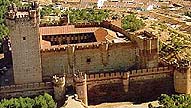 |
La Mota refers to a natural or artificial mound or hill upon which a castle is built (in English "motte"). Thus there are several castles in Spain called La Mota. The "castillo" at Medina del Campo (City of the Fields) is one of the most formidible in Spain, reflecting the wealth and prestige of the town of Medina del Campo, where famous Fairs were held for 50 days each in the spring and fall. Merchants from not only Spain, but France, Italy and North Africa traded merino wool, agricultural products, books, art and many other goods. The castle probably began as the 12th century villa of an wealthy Almoravid or Almohad Muslim merchant.
|
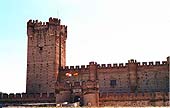 |
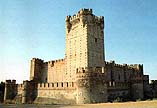 |
The oldest part of the current castle dates from the beginning of the 13th century, when Alfonso VIII (who began his reign in 1158 at the age of three) built his modest castle (now the inner ward) upon the remains of the Moorish villa. The inner ward was enhanced in the 14th and 15th centuries and augmented by Henry IV, who oversaw construction of the outer wall and towers, and Queen Isabella the Catholic, who built the remarkable keep, the Tower of Homage. The castle does not appear to be terribly formidible as you approach it from a distance, but as you near the fortress you see that it is surrounded by a wide, deep dry moat! The two-story batter at the base of the entire outer wall contains two tiers of arched passageways (see photo below right) for bowmen, in addition to the ground level arrowslits and the battlements above. And did I mention the towers at each corner, and the drawbridges guarding the main and postern gates? Note as well the minimal number of windows in the Inner Castle, which has only one entrance.
|
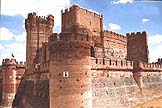 |
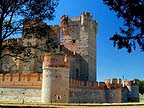 |
Alfonso VIII has the dubious honor in 1195 of being the last Spanish king to lose a major battle to the Islamic Berbers. In 1212 a joint counter-attack by the forces of León, Castile, Navarre and Aragon devasted the forces of the Almohad ruler, Abû Yûsuf Ya'qûb, and the Reconquista was underway. A single reference to Christopher Columbus visiting Queen Isabella at La Mota to request money for his famous expedition west to "India" could not be confirmed. Captured only by a 10-month seige and trickery, the castle was eventually a prison for the likes of Blanca de Borbón, Caesar Borgia, and Hernando Pizarro, brother of the famous explorer and conqueror. The castle was restored in 1939-40 and is both open to the public and a conference center. |
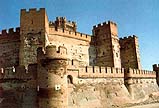 |
Photos of the Lego Model under construction
in February 2003
|
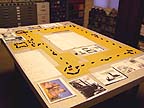 |
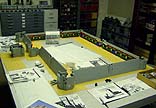 |
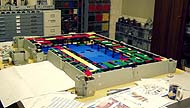 |
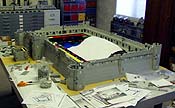 |
The 'castillo' is laid out on tan
baseplates to match the soil. |
The massive batter (unseen
from afar) is built first. |
The substructure for the outer
ward is built next... |
Then the outer curtain can be
added atop the batter! |
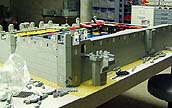 |
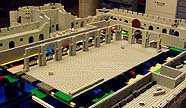 |
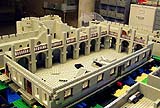 |
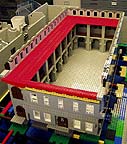 |
The small postern gate was also
protected by a drawbridge. |
It's now time to begin work
on the Inner Ward. |
The second of three stories
begins to take shape. |
The walkway is covered and
work on the 3rd story begins. |
Photos of the Lego Model
in February-March 2003
The model is built with 22,633 Lego bricks - my 3rd largest [see FAQ]. |
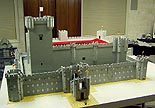 |
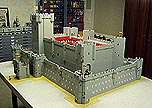 |
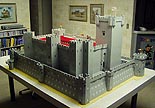 |
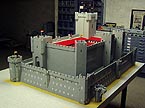 |
The view fron the NNW shows
an impressive face to the visitor. |
From the West, the Chapel
Tower is impressive. |
From the ESE, the outer
turrets can be appreciated. |
The view from the South
shows the Postern Bridge. |
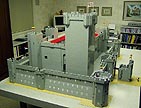 |
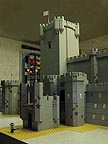 |
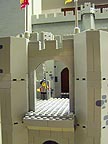 |
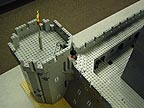 |
From the Northeast, the massive
donjon is most impressive. |
The view of the Barbican
(sans land bridge) and Outer
Gate dissuade the unwelcome. |
The guard on the Barbican
appears to be wide awake. |
A soldier enters the unique
North Turret. |
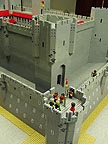 |
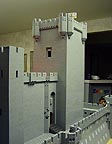 |
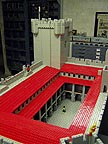 |
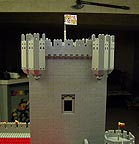 |
We're in luck! King Ferdinand
and his Queen Isabella are atop
the West Turret, with advisors. |
The Gate into the Inner Ward
is well placed under the watch
of the high Donjon. |
The lavish Inner Courtyard
contrasts the stark exterior! |
The Donjon turrets are well
designed...and beautiful. |
Build Your Own
When I originally designed this castle in 1993, my pictures were all black & white images from the copy
machines of various libraries. I did not have much history or detail, and designed the castle as though it
had a wet moat. When pictures on the internet and in my two newly acquired books confined to Spanish
castles clearly showed a dry moat and arrowloops studding the batter, I redesigned the Lego model on the
fly. Thus plans are pretty useless, though I've put what I have below They do convey the majesty of La Mota.
|
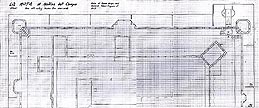 |
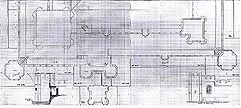 |
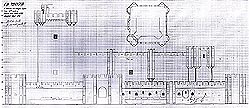 |
Southeast half of the Lego Plan
|
Northwest half of the Lego Plan
|
Lego Elevation of the Castle's front
|
Other Castillo de la Mota, Medina del Campo pages:
http://www.castillosdejirm.com/lamota.htm
http://www.castles.org/castles/Europe/Western_Europe/Spain/spain6.htm
http://casl.umd.umich.edu/hum/spanishco/06.arte_medieval/images/195MedinaCampo.C stMt.51014c.jpg
http://wmatem.eis.uva.es/~dmde02/Cmota.html
Return to the main castle page.
Castles created by Robert Carney
Webpage created and maintained by Robert Carney